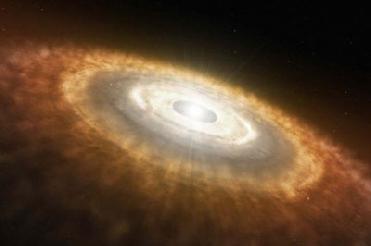
Astronomers studied the solar system, from the swirling disk called
NEW DELHI (BNS): Astronomers from University of Arizona have observed the unprecedented detail of the making of stars and planets in nascent solar systems.
According to a Science Daily, the discoveries, published in the Astrophysical Journal, provide a better understanding of the way hydrogen gas from the protoplanetary disk is incorporated into the star.
Joshua Eisner an assistant professor at UA's Steward Observatory and his team found swirling clouds of gas and dust that feed the growing star in its center and eventually coalesce into planets and asteroids to form a solar system. They coupled both Keck telescopes on Mauna Kea in Hawaii with a specifically engineered instrument named ASTRA (ASTrometric and phase-Referenced Astronomy) to see the protoplanetary disk.
The big challenge facing Eisner's team lies in obtaining the extremely fine resolution necessary to observe the processes that happen at the boundary between the star and its surrounding disk -- 500 light years from Earth.
"The angular resolution you can achieve with the Hubble Space Telescope is about 100 times too coarse to be able to see what is going on just outside of a nascent star not much bigger than our sun," Eisner, said in a Science daily Journal.
Combining the light from the two Keck telescopes provides an angular resolution finer than Hubble's. Eisner and his team used a technique called spectro-astrometry to boost resolution even more.
By measuring the light emanating from the protoplanetary disks at different wavelengths with both Keck telescope mirrors and manipulating it further with ASTRA, the researchers achieved the resolution needed to observe processes in the centers of the nascent solar systems.
Protoplanetary disks form in stellar nurseries when clouds of gas molecules and dust particles begin to collapse under the influence of gravity.
Eisner's team pointed the telescopes at 15 protoplanetary disks with young stars varying in mass between one half and 10 times that of our sun. This sample of disks, all located in our own galaxy, the Milky Way, represents by far the largest of its kind.
Astronomers have chosen young solar systems for their study, probably a few million years old.
"These disks will be around for a few million years more, by that time, the first planets, gas giants similar to Jupiter and Saturn, may form, using up a lot of the disk material, � Eisner said.
More solid, rocky planets like the Earth, Venus or Mars, won't be around until much later.
"But the building blocks for those could be forming now," he said, which is why this research is important for our understanding of how solar systems form, including those with potentially habitable planets like Earth.
The ASTRA project was made possible by a Major Research Instrumentation Grant from the National Science Foundation.
 Previous Article
Previous Article Next Article
Next Article













The Indian Air Force, in its flight trials evaluation report submitted before the Defence Ministry l..
view articleAn insight into the Medium Multi-Role Combat Aircraft competition...
view articleSky enthusiasts can now spot the International Space Station (ISS) commanded by Indian-American astr..
view article